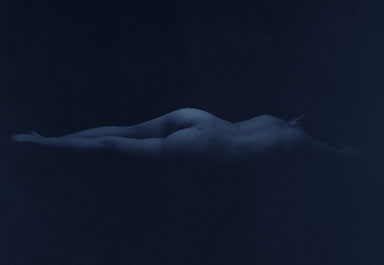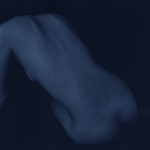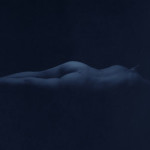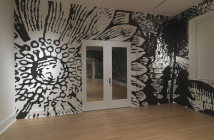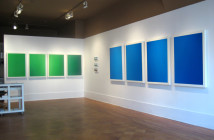The human eyes consist of two different types of photoreceptors, rods and cones, which send information to the brain for interpretation. The rods number in the 120 million and are far more sensitive than their counter–part, the cones. The interesting part of human anatomy is that the rods are not in any way sensitive to color. The job of color function is left to the 7 million or so cones. This small little understanding of how the human eyes function may shed some light, no pun intended, on why I prefer black and white, or monochromatic, photography to color. At a recent opening reception in Providence RI, a RISD professor explained to me that a glass of wine will sharpen the ability of the rods and cones to perceive lights and darks. Wine, mmmm. I’m sure the above information is a factor in why I’m so attracted to the Kenro Izu exhibition, Nudes and Still Lifes at Robert Klein Gallery on Newbury Street.
My first experience with the work of Kenro Izu was last winter at theGriffin Museum of Photography in Winchester, MA. Izu’s cyanotype over platinum palladium prints were included in the museum’s The Body Familiar: Current Perspectives of the Nude exhibition. Izu’s fine art career is only 50% of his work. From the looks of his website his commercial work as a photographer seems to be just as sought after.
Born in Osaka, Japan, he relocated to New York City in the 1970’s. In 1983 Izu committed to working in the contact-printed platinum palladium process for the next two decades. In 2002 Izu developed his cyanotype over platinum palladium process. The platinum palladium process is noted for being a very stable method of processing photographs.
Izu’s current exhibition Nudes and Still Lifes is a variation of the exhibition titled “Blue” which was first assembled in 2004 for the Howard Greenberg Gallery (NYC); then exhibited at Galleria Carla Sozzani (Milan), and finally shown at Shimose Fine Art (Tokyo). The noticeable difference here is an exploration of different subject matter with the inclusion of four platinum palladium landscape prints and five still life cyanotype platinum palladium prints. The four landscapes reveal a more traditional side to Izu’s photography; they reflect the quality that is the standard with all fine art black and white photography.
I can’t help but make some type of association with the cyanotype prints. Whether it is the nudes or the still lifes, the photographs have an undercurrent of sentimentality that seems familiar. It puzzled me at first. Then I realized I was associating the cyanotype prints with Picasso’s blue period (1901-1904). Picasso’s Femme Nue II, from 1902, could have easily been the inspiration for Izu’s “Blue #1010b, 2004; which is number 5 of an edition of 10. Both the Izu print and Picasso painting share the same primary composition. A female nude placed in the center of the picture plane, with legs crossed, back towards the viewer, with the upper torso leaning forward between the crossed legs.
The obvious difference with the two pieces is that Picasso understood what he could accomplish with paint; Picasso in the most direct way is a totally narcissistic painter. As for Izu, it seems to be the subtlety in tonal contrast that matters as much as the traditional subject matter he has chosen. It could also be that Izu understands his target audience. What’s interesting to note is that 4 of the 10 prints of Blue #1010B were sold; maybe other viewers have also had made the connection to Picasso’s Femme Nue II”
It would be hard to fathom, or even separate, the ideas of art as commerce and art as artifact. For some artists, such as Kenro Izu, it’s a natural and seamless bridge between the two ideas. Bear in mind that real life ebbs and flows just as the art market does. An artist will tell you that at the end of the day you have to pay the bills, so if you’re a proficient technician, such as Izu is, you transcend the commercial content and still produce a genuine product without turning yourself into a street walker. Man Ray worked commercially in the 1920’s for Vogue Magazine, without hampering or sabotaging his artistic sensibility or legacy.
Links:
Robert Klein Gallery
Griffin Museum of Photography
"Kenro Izu: Nudes and Still Lifes" is on view until November 4th at Robert Klein Gallery, located at 38 Newbury Street, in Boston.
All images are courtesy of the artist and Robert Klein Gallery

